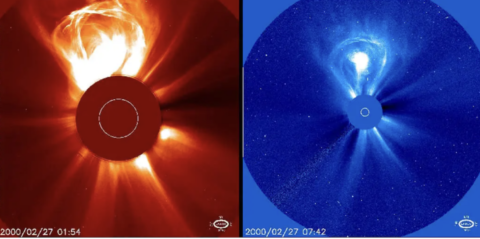NASA’s Parker Solar Probe spacecraft is speeding up as it orbits the sun. By late 2024, it will reach a whopping 430,000 miles per hour. The probe is capturing unprecedented data about our star.

Over the past couple years, NASA’s Parker Solar Probe has continually smashed its own speed records. And in the next year, it will continue to break more records.
The agency’s well-fortified spacecraft is swooping progressively closer to the sun, and during each pass, picks up more speed. In 2018, soon after its launch, the probe became the fastest human-made object ever built, and by 2024 it will reach a whopping 430,000 miles per hour.
At such a speed, one could travel from San Francisco to Washington, D.C., in 20 seconds.
The spacecraft recently reached 394,736 mph. “It’s very fast,” Nour Raouafi, an astrophysicist at the Johns Hopkins Applied Physics Laboratory and project scientist for the mission, told Mashable.
The spacecraft, fitted with a thick heat shield, has been making passes through the sun’s outer atmosphere, also known as its corona. It’s the first mission to reach the corona, and the unprecedented data collected will help scientists forecast how eruptions from the sun’s surface will impact Earth, and answer research quandaries about the solar wind — the stream of particles and radiation constantly emitted by the sun.
“It’s like opening a new book that we’ve never read before,” Raouafi said.

Credit: NASA / Johns Hopkins APL / Steve Gribben
How the solar probe goes so fast
Parker’s exceptional, increasing speed is an inevitable part of orbiting the sun, a sphere of hot gas 333,000 times as massive as our dense planet. For another perspective, 1.3 million Earths could fit inside the sun. Crucially, when you swing by such a massive and gravitationally powerful object, you pick up a lot of speed.
The spacecraft is now flying its 17th orbit around the sun, allowing the craft to boost its speed by over 240,000 mph since 2018. And out in space, there’s nothing to stop this motion. “Once it’s going, it’s going,” Raouafi said. (The probe strategically passes by Venus for “gravity assists” that propel it closer to the sun; these Venusian flybys minimally slow the craft, but ultimately result in it picking up even more speed as it zips nearer to the massive star.)
At such a torrid pace, the craft begins a new orbit every three months, allowing its instruments to collect a wealth of information about the solar environment. “Every three months we have a new load of new data,” marveled Raouafi. “It will take years and years to study.”
How the probe will unravel solar mysteries
Space weather researchers have some weighty questions. They want to know why the solar wind accelerates after it leaves the sun, reaching up to 2 million mph. They want to grasp why the corona (which reaches 2 million degrees Fahrenheit) is so much hotter than the sun’s surface (it’s 10,000 degrees Fahrenheit). And they want to understand how extreme space weather, caused by different types of solar explosions, can behave and ultimately impact Earth.
A particularly threatening solar eruption is called a coronal mass ejection, or CME. These occur when the sun ejects a mass of super hot gas (plasma). “It’s like scooping up a piece of the sun and ejecting it into space,” NOAA space weather scientist Mark Miesch told Mashable earlier this year.
These events can wreak havoc on our power grids and communication networks. Infamously, a potent CME in 1989 knocked out power to millions in Québec, Canada. The CME hit Earth’s magnetic field on March 12 of that year, and then, wrote NASA astronomer Sten Odenwald, “Just after 2:44 a.m. on March 13, the currents found a weakness in the electrical power grid of Quebec. In less than two minutes, the entire Quebec power grid lost power. During the 12-hour blackout that followed, millions of people suddenly found themselves in dark office buildings and underground pedestrian tunnels, and in stalled elevators.”

Credit: SOHO / ESA / NASA
Want more science and tech news delivered straight to your inbox? Sign up for Mashable’s Light Speed newsletter today.
The Parker solar probe’s researchers expect the spacecraft, fitted with instruments to measure and image the solar wind, will enable us to better forecast when and where a potent CME may hit. For example, when a CME erupts from the sun’s surface, it must travel over 92 million miles to reach Earth, but along the way this hot gas will “pile up” the solar wind ahead of it. “That will affect its arrival time to Earth,” Raouafi said. Knowledge about these space dynamics is critical: A good space weather forecast would allow power utilities to temporarily shut off power to avoid conducting a power surge from a CME, and potentially blowing out power to millions.
On the outskirts of the corona, the spacecraft is relentlessly exposed to brutal heat and radiation, and in September 2022 it flew through “one of the most powerful coronal mass ejections (CMEs) ever recorded,” NASA said. Yet the craft remains in great shape. That’s largely thanks to a 4.5-inch-thick carbon heat shield that’s pointed at the sun. The shield itself heats up to some 2,500 degrees Fahrenheit, but just a couple of feet behind the shield, the environs are surprisingly pleasant.
“Most of the instruments are working at room temperatures,” Raouafi said.
















